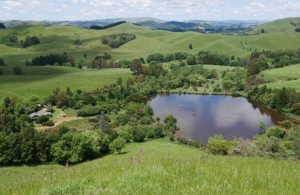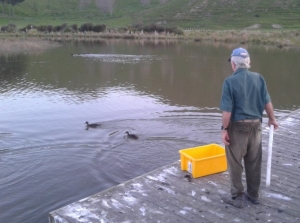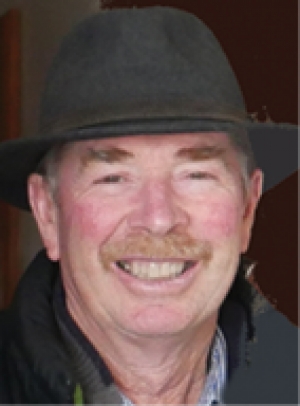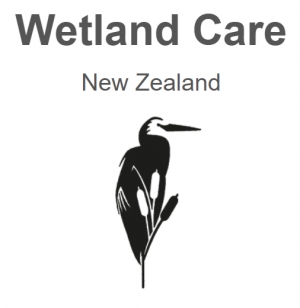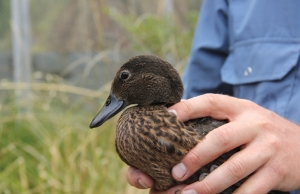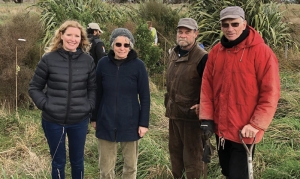Super User
Handy guide defines what makes a wetland
The first step in protecting wetlands is being able to identify them. To help landowners identify wetlands on their property, Greater Wellington has developed a guide: Spotting a wetland on your land.
This guide is a set of durable flip cards designed to be used outside, containing photos of different wetland types and plant species likely to be found in and around wetlands. Greater Wellington is also helping landowners to protect and manage waterways through its Healthy Waterways programme. This support can include help with the cost of fencing, pest control and planting.
If you have any questions about wetland identification or are planning to do anything in or around waterways or wetlands, get in touch for free specialist advice at This email address is being protected from spambots. You need JavaScript enabled to view it. or This email address is being protected from spambots. You need JavaScript enabled to view it..
For more information visit www.gw.govt.nz/healthy-waterways.
Welcome to my world
Pockets of the 508-hectare farm resemble an arboretum, with precious specimen trees fenced and surrounded by other trees planted there to protect it from stock and the elements.
Years ago Jim attended a Landcare lecture about having a good influence on the land.
Today the giant eucalypts, the valuable Tasmanian blackwoods (Acacia melanoxylon) (a good straight trunk can be worth $4,000 a cubic metre, says Jim), Douglas firs and Oregon pines, totara, sturdy pin oaks, giant redwoods, some kahikatea that Forest & Bird gave him, towering Leyland cypresses planted to screen the farm from SH2, tupelos and liquidambars with their brilliant autumn colour and hundreds of others are all testament to how he carefully he took that lecture to heart.
He is watching the progress of a hybrid oak he got from Appletons Tree Nursery in Nelson, a Quercus robur ‘Fastigiata’, which has an elegant upright shape and appears to be thriving.
The kanuka and manuka, which are almost in full flower (“it’s nearly time to tell the beekeeper in bring more hives”), have gained more value – “from cutting it and bulldozing it, I am now planting it... for the bees”.
On his daily rounds of the farm that his son, Simon, now runs, Jim gets a lot of pleasure seeing the trees stake their claim on the land, both the trees that preceded him and the ones he has planted. The biggest rata on the property was there long before he took over the farm.
“I thought the stock were going to kill it because they used to camp under it so that’s why we fenced it off and planted around it; that tree is now worth about $5,000 to me”, but it’s not a cost that Jim begrudges.
It’s clear to see Jim, who is now in his mid-70s, loves his trees.
When he ran the farm, which has been in his family for more than 150 years, it was about 60:40 cattle to sheep, with 200 station cows. Now his son runs 40 station cows but he’s also rearing bulls, which is cheaper than buying them in.
They are mostly speckle park crosses and angus hereford crosses.
Jim enjoys still being part of the farm and helps out with the haymaking – mowing paddocks – and checking on stock and other tasks. “I need to get
out – this morning I’ve done a couple of hours of spraying,” he said.
In line with current regulations, and with more stringent rules around the fencing of waterways likely, Jim says his son is lucky because a lot of it, along with planting, has already been done. “We were ahead of our time. We did it mainly to control the river wood trees, which were taking fences out.”
Simon is now trialling different tree varieties to carry on the planting but it is still going to be a massive cost to ensure all the waterways are compliant. The planting has other benefits as well as keeping stock out. Jim has discovered that a one-kilometre section of one of the streams that has established trees along it is about 2 degrees Celsius cooler because of the shade.
The Te Mara stream goes into Waipoua River on the property but by the time the Waipoua has reached Masterton, it has accumulated a lot of water, from the Kiriwhakapapa, Mikimiki and Matahiwi streams as well.
About 20 acres (8ha) of the property between the woolshed near the homestead, where Simon now lives, to where Jim lives above the “Big Pond” is covered by a QEII covenant. Jim thinks now that the covenant should be extended to another area on the farm called Norm’s Marsh.
It was built in tribute to Norman Marsh, a great supporter of DU and generous benefactor when it came to paying for the cost of creating wetlands, several – on Jim’s and other properties – thanks to Norm’s largesse. Jim, who was made a Member of the New Zealand Order of Merit for his services to conservation in 2016, is a life member of the QEII National Trust.
The property has about 32 ponds in all. One was created after former DU president John Cheyne, on a visit to the farm, suggested a particular rushy patch would make a good wetland. “It took me three days to bulldoze it and I had to hire a digger for a half-day,” Jim says. Another he calls the “10-Minute
Wetland” – “that’s how long it took to block the end of it with a bulldozer – a pair of shoveler nested there this year and had five ducklings”.
On the big pond, Jim’s two mute swans, which he suspects are both male,compete with scores of scaup for the daily treats delivered by Jim. He says there were 32 scaup ducklings on the pond last year. As well as feeding the swans and scaup and other ducks, Jim has more for the pheasants, Cape Barren geese and quail that frequent the lawns around the house.
The other birds that visit the farm also have plenty to feast on. There’s dragon’s gold kowhai and kaikamako for the tui and bellbirds, tree lucerne,
or tagaste, for the wood pigeons and Himalayan strawberry trees, which all the birds love. He notes that the lucerne makes excellent firewood, “as good as maire”, something that many people don’t realise.
A welcome distraction over Christmas and New Year, as Jim recovers from an injury, has been the arrival on the lawn of some baby quail looking “like little bumblebees”.
He has been trying to breed quail for several years – there were five last year – but this year he has spotted one pair with 11 chicks, one with three and another with two chicks. “I can just look out the window and see them feeding on the lawn. It’s just magic to have them around all the time.”
For Jim, one of his favourite times of day is at night – sitting out on the deck having a whisky, with the Cape Barren on the lawn and the pheasants coming up to use the automatic feeder, and quail running along the deck.
Kimi's special high country mission
Kimi, the world's only bittern dog, recently took a break from her usual job of looking for bitterns to take on a special role for her best friend, DU Director Emma Williams. She was to be ring bearer at Emma and bat expert Colin O'Donnell's wedding.
The couple were married on 3 January at Criffen Station, a high country station in Wanaka. We assume bitterns and bats are regular breakfast conversations for the newlyweds.
Congratulations Emma and Colin.
DUNZ Scholarship awarded
The first Ducks Unlimited scholarship has been awarded to Shannon Bentley who is studying for a master’s degree at Victoria University of Wellington. Shannon’s research will include field work at the Wairio wetland.
She is originally from the Wairarapa.
DU is planning a small presentation at the university to award the scholarship to Shannon in March 2020.
Land of the First Light
For this year’s annual conference and AGM, Ducks Unlimited members will head east to Gisborne, land of the first light.
The venue for the conference, being held on 31 July and 1 August, will be the Emerald Hotel in the heart of the city.
A treat is in store for the field trip, with Nick’s Head Station in Muriwai agreeing to let delegates and their guests visit its wetland on Saturday, 1 August. Organisers are arranging for three speakers during the wetland visit.
They are:
- Kim Dodgshun, manager of Nick’s Head Station – welcome and introduction
- Steve Sawyer, owner/operator of EcoWorks, which implements many conservation activities at Nick’s Head
- Sandy Bull, a driving force behind much of the conservation work in Gisborne.
Nick’s Head Station is by the ocean so an alternative may be required if the weather does not allow the visit to go ahead as planned.
At this stage it is suggested to have the speakers at the Knapdale Eco Lodge if the weather is too bad.
Knapdale is somewhat protected in poor weather so it may be possible to view the wetlands there instead.
But, with Gisborne having the second highest sun hours in the country, conference organisers are hopeful DU can visit Nick’s Head Station.
From the President
Hi everyone, I hope you survived the festive season unscathed.
I developed a headache over the summer which has just got steadily worse, and I think it has something to do with banging my head against a brick wall by the name of “BUREAUCRACY”.
Last time I told you we had at last got consent to divert water from Matthews Lagoon into the Wairio wetland, unfortunately the job was not completed before the wet weather set in last autumn and consequently the canal wall failed.
Also the waters have now been muddied by the fact another outside person has come along saying there are some rare species of aquatic life that need to be protected and the water should not be put into Wairio.
As the argument rolls on, the summer is slipping by with nothing being done and I am beginning to despair.
That is my rant for the month and I look forward to seeing you all in Gisborne.
Wetland Care Scholarship
Interested in studying wetland birds or wetland restoration? – the Wetland Care Scholarship could be for you!
Background/purpose
Wetland Care Research Scholarships are Ducks Unlimited-sponsored scholarships applicable to any student currently enrolled or affiliated with a New Zealand university.
Funds are aimed at encouraging and supporting students who wish to push the boundaries of what is known about wetland restoration and conservation and whose projects are designed to facilitate better management of New Zealand wetlands or their environment.
Up to $20,000 is available each year to cover one to four separate scholarships of $5000 each. Funds can be used to support student living costs or to cover the costs of equipment purchase, logistics and consumables.
Criteria
Applications will be accepted from students/researchers affiliated with universities interested in making a difference through wetland conservation.
The student project must be based in New Zealand. Preference will be given to applications that demonstrate:
■ projects of direct benefit to New Zealand based on current wetland conservation issues.
■ innovative thinking that pushes the boundaries of what is known about New Zealand wetland conservation.
■ research on native threatened wetland bird species.
■ research with clear objectives and measurable outcomes.
■ research with a strong wetland management and conservation applications.
■ research covering any ‘preferred research topics’ listed on the Ducks Unlimited/Wetland Care website.
Value
Wetland Care will award up to four scholarships a year, in two funding rounds each year for the next three years. The current round, consisting of one or two $5000 scholarships, is being advertised now for 2020.
The next funding round, consisting of another one or two $5000 scholarships, will be advertised early next year. Funds will be paid in one lump sum to successful candidates upon completion of the milestones agreed at the time the scholarship is accepted.
Interested? Or want to know more?
Please email us at This email address is being protected from spambots. You need JavaScript enabled to view it. with your questions or to request an application pack.
Terms and conditions and an application form are available on the Ducks Unlimited website: www.ducks.org.nz/wetland-care/scholarships.
Applications for the current round close on 1 November 2019.
Trapping of predators must continue
Ian Jensen writes about the ‘necessity of continuance’ in the war against pests.
For several years, no records were kept to show the numbers of predators dispatched on the property, though one Tims trap early on accounted for about 35 ferrets over three years.
In February 2008 a comprehensive record was started, compiled mainly from pests that my dogs found, hares that keen hunters dispatched, along with wasp nests that have been eliminated as well as bait stations for rats and mice.
In 2009, with assistance from Greater Wellington Regional Council, a number of DOC 200 traps were provided, and others have been purchased since.
The property is coastal dunes south of Te Horo, with about 10 hectares of wetland, where there are nine traps located on the wetland margins. Weasels are the predominant catch, followed by stoats, rats and ferrets and a few small to medium rabbits.
It seems bird numbers, particularly pheasants, have increased over recent years along with Californian quail. With the ducks, it is harder to make a comparison as water levels also play a very important part in the survival of the young and moulting birds.
For my traps I use the juice from ‘Sardines in spring water’; I have a small sealed container kept in the fridge that I store it in – once every three months seems to be enough to keep up the interest.
Some say it is not counting the numbers caught that matter, but it is the numbers still around that matter. However counting the numbers caught keeps one well motivated to continue the onslaught.
In 2017 there were 29 weasels and four stoat caught, while in 2018 that dropped significantly to four weasels, three stoats and a ferret.
This year has spiked with 21 weasels, 16 stoats and two ferrets – we also passed the 500 mark with hedgehogs since records began.
Pateke numbers improving
The brown teal (pāteke) is one of three endemic teal to New Zealand and the only one to fly. Both the Auckland Island and Campbell Island teal are flightless.
Mainly nocturnal and half the size of a mallard, this shy, omnivorous duck spends time on land foraging for invertebrates, seeds, fruit, grass, and foliage. With dark brown plumage, the males are particularly distinctive from their female counterparts during breeding time in late winter.
The slightly larger males in breeding plumage obtain a green iridescence on their heads, a dark chestnut breast plus occasionally a thin white neck ring too.
Like many of our native birds, this small-necked dabbling duck has dramatically suffered from mammalian predators, loss of habitat and hunting, resulting in a plummeting population to only 700 birds in the wild by the 1990s.
Brown teal were once widespread, but thanks to brown teal species co-ordinator Kevin Evans and the Department Of Conservation brown teal recovery group, in the past 15 years, this population decline has not only been halted, but reversed, building up to about 2500 birds in the wild today.
Numbers are slowly recovering and there are several contributors to this success:
Captive breeding facilities across New Zealand that produce birds for release.
The Isaac Conservation and Wildlife Trust (ICWT), which provides facilities for flock mating for other institutions, and breeding plus pre-release conditioning and processing (banding, transmitter attachment, worming, disease screening, etc). Every captive raised bird goes to ICWT as its aviaries have stream-fed waterways for foraging, plus special feeders where the brown teal learn to obtain food. These feeders are also located at release sites.
DOC together with community groups undertake intensive predator control at release sites.
There are generally four releases of brown teal a year and the latest release of 32 birds was in August in the Abel Tasman National Park in an area managed by Janszoon.
Preparing the birds for release is an exhausting but rewarding task for all those involved at ICWT (assisted by Kevin Evans).
All release sites are vigorously assessed to ensure pāteke are released into areas with adequate protection and habitat to support self-sustaining populations.
[Ducks Unlimited was instrumental in early conservation efforts from 1975 with its ‘Operation Pateke’, New Zealand’s first large-scale co-ordinated brown teal breeding programme. – Editor]
Bittern steals the show
Ducks Unlimited recently received a substantial donation to put towards its restoration work at Wairio Wetland.
Janet and Patrick Velvin, who live in South Wairarapa, are passionate about conservation, particularly water conservation, and contacted The Gift Trust, a philanthropic advisory service, to identify suitable causes they could support.
Cheryl Spain, executive director of The Gift Trust, said they had been impressed with the research on Wairio and DU’s partnerships with the Department of Conservation, Greater Wellington Regional Council and Victoria University, particularly its links with the student research projects at Wairio, and had chosen Wairio as a suitable recipient.
The Velvins visited the wetland for the first time and took part in a planting day with Victoria Uni students in early July.
After helping with the planting, they were given a guided side-by-side tour by Ross Cottle, who identified a suitable site on a promontory for a viewing hide, which could be constructed with some of the funds donated by the Velvins.
During the tour, Patrick asked if there were bitterns in the wetland, and as if on cue, a bittern obliged and flew in front of the them.
Janet became aware of the work at Wairio Wetland through the book Wairarapa Moana: The Lake and its People.
Janet said after the tour they were impressed with Ducks Unlimited and happy to give a donation towards the work at Wairio.


